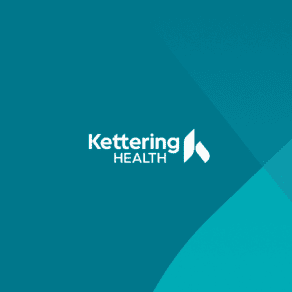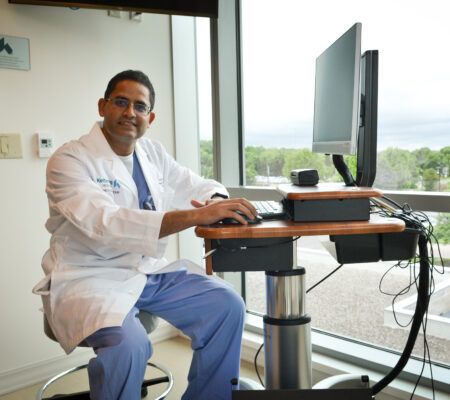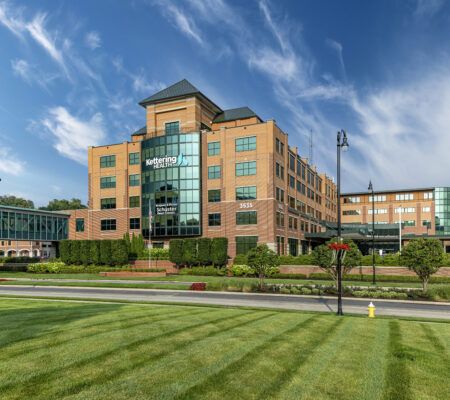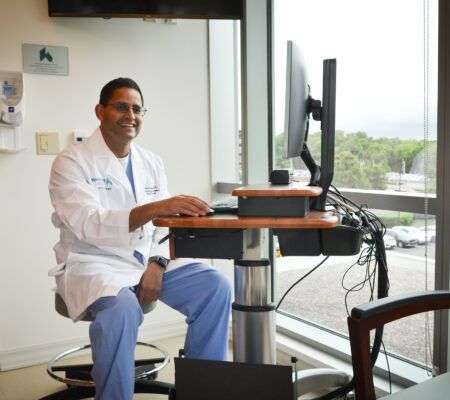Kettering Health Main Campus (formerly Kettering Medical Center) was the first hospital in the nation to earn accreditation as a Comprehensive Stroke Center by the Healthcare Facilities Accreditation Program (HFAP). We have the technology and expertise to save lives and preserve brain function.
Our Approach to Stroke Care
When minutes matter, we use the latest technology to provide lifesaving care. We have a team of expert physicians, stroke-trained nurses, and support staff who work together to stop strokes and reverse their impact. Our comprehensive-care approach provides specialized rehabilitation to help our patients return to their prior level of function to support the best quality of life.
Types of Stroke
The strokes we treat are categorized as the following:
- Hemorrhagic strokes: caused by a burst aneurysm (weakened, bulging areas of a blood vessel)
- Ischemic strokes: caused by a blood clot or narrowed blood vessel
- Transient ischemic attacks (TIAs): caused by temporary a blood-flow disruption (also called “mini strokes” or warning strokes)
Stroke Diagnosis
A fast diagnosis is key to providing stroke treatment in a safe time window. We use the latest diagnostic tools to assess your stroke as quickly as possible.
Telestroke services
All of our emergency centers offer telestroke services. Once you arrive at an emergency center, a stroke expert evaluates your condition through a video conference. We immediately determine if you need medication or surgery.
Neuroimaging
We use the RAPID™ imaging platform to locate the exact location of a blood clot. This software analyzes CT scans of your brain to help us determine if you need a thrombectomy (surgery to remove a blood clot).
Stroke Treatments
Our stroke treatments focus on stopping your stroke and reversing damage. Neurologists, neurosurgeons, and neurointerventional radiologists work together to deliver timely care.
Clot-dissolving drugs
We use tissue plasminogen activator (tPA) to dissolve blood clots causing ischemic strokes. This clot-dissolving drug is given as quickly as possible after symptoms start (within four hours). You may receive tPA systemically (through a vein in your arm) or intra-arterially (through a catheter, or flexible tube).
Thrombectomy
A thrombectomy is a minimally invasive emergency surgery to remove a blood clot. A neurointerventionalist makes a small incision in your wrist or groin. They thread a catheter through a blood vessel to the location of the clot. Using a stent retriever (an expandable device that grabs the clot), we remove the clot and restore blood flow to the brain.
Endovascular surgery
At Kettering Health, we offer advanced endovascular procedures to prevent strokes. Neurointerventionalists use catheters to perform the following minimally invasive surgeries inside blood vessels:
- Carotid angioplasty and stenting to widen narrowed arteries
- Endovascular coil embolization to prevent brain bleeds due to burst aneurysms
Learn more about our endovascular surgery.
Stroke Support and Rehabilitation
We’re ready to help patients through every phase of stroke recovery.
NeuroRehab and Balance Center
The NeuroRehab and Balance Center is an outpatient neurological therapy clinic focused on improving patients’ function and quality of life.
We provide programs tailored to an individual’s needs—including physical, occupational, and speech therapy, as well as case management and exercise physiology.
Vagus Nerve Stimulation
Using Vivistim, a small implant, we can help stroke survivors regain mobility through nerve stimulation paired with physical therapy.
During physical therapy, the implant is activated to stimulate the vagus nerve. This is done while patients practice everyday tasks to help the brain form new neural pathways, bypassing areas damaged by a stroke.
This treatment can greatly improve hand and arm function.
Some insurances cover Vivistim. Please call your insurance provider to discuss your coverage.
For more information or if you are interested in this treatment, call (937) 200-1199.
Support Survivors Group
Connecting with other stroke survivors is essential to recovery. Through the Stroke Survivors Group, stroke survivors can share their experiences. The group is open to family members and caregivers.
The Stroke Survivor Group meets at Kettering Health Main Campus on the fourth Wednesday of each month from 6 to 7 p.m. in the Nelson Conference rooms.
For more information about the Stroke Survivors Group, call (937) 395-8099.
Strokes Are on the Rise in Young People
According to the American Stroke Association, strokes occurring in younger adults are up 44% in the last decade.
Read More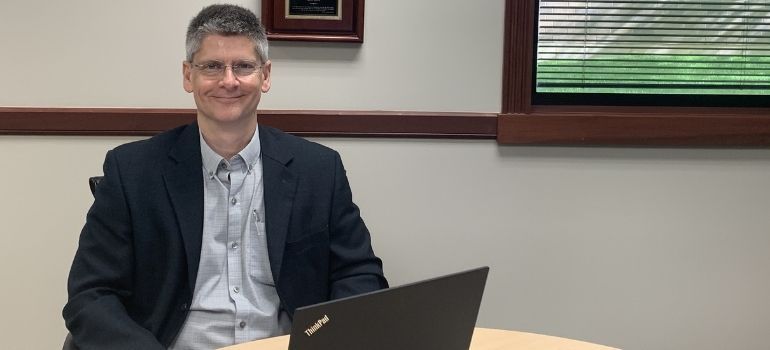
Treatments
- Clot-dissolving Drugs
- Endovascular Surgery
- Thrombectomy
- Vagus Nerve Stimulation


